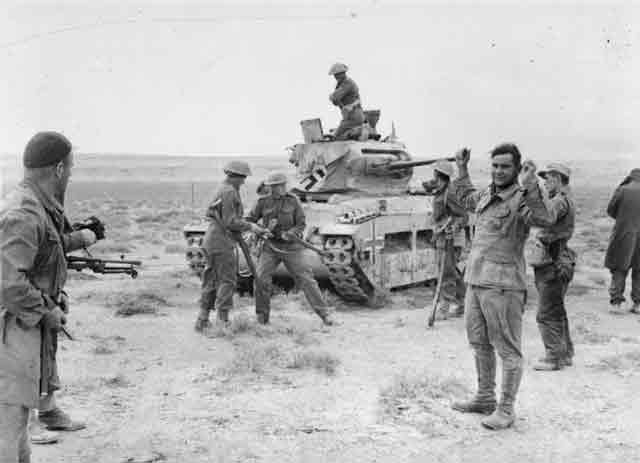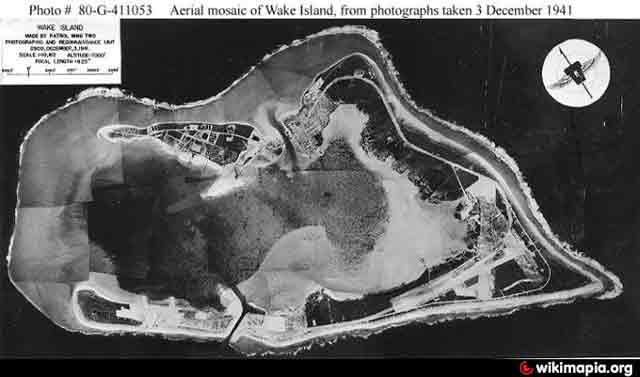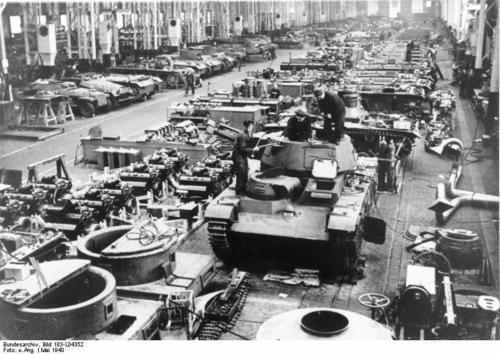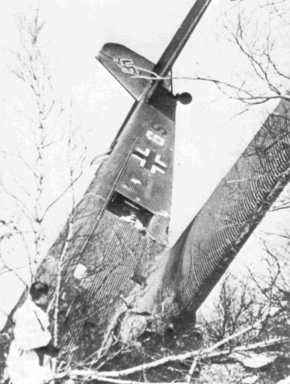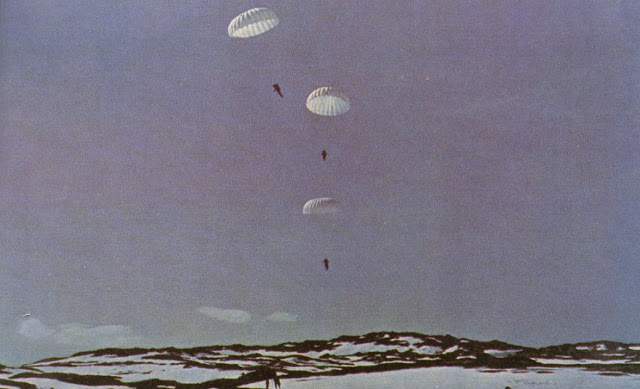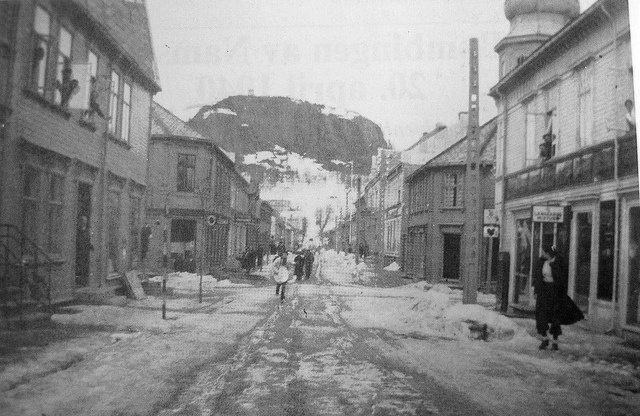Tuesday 16 July 1940
 |
| RAF Boulton Paul Type A Mk.IID Defiants flown by Squadron Leader Philip Hunter (PS-A) and the rest of his force in July 1940. The Defiants, long forgotten by most casual students of the war, remained in the front lines at the time. |
Battle of Britain: Hitler releases Fuhrer Directive No. 16, "On Preparations For A Landing Operation Against England" on
16 July 1940 It is an odd Fuhrer Directive, because in the preamble Hitler admits that he would prefer not to have had to issue it. He provides that he will only actually order the invasion (which he gives the codename "Unternehmen Seelöwe -- Operation Sea Lion") "if necessary":
Since England, in spite of her hopeless military situation, shows no signs of being ready to come to an understanding, I have decided to prepare a landing operation against England, and, if necessary, to carry it out.
"Preparing" an operation to be carried out "if necessary" is not the usual Hitler command strategy, where he says to do something and expects it to happen. The body of the order also is highly equivocal, with multiple qualifiers such as "I reserve the decision to myself," wildly unrealistic preconditions that "must" be met, and the qualification that the Luftwaffe "must attempt" to neutralize the Royal Navy "as far as possible." The language in the order shows that Hitler is not a big fan of Operation Sealion, and actually is looking for ways to avoid carrying it out - not a good way to inspire confidence in his infallible judgment.
The plan itself is straightforward. There will be a "wide front" on the southern coast of England west of the Isle of Wight, with possible preliminary limited operations such as the occupation of that island. Some of the preconditions are wildly unrealistic, such as mining the Straits of Dover so they are "closely sealed off with minefields on both flanks," something that the Wehrmacht is not even close to being able to do (though the Royal Navy effectively achieves it in 1944). If nothing else, the Directive shows how unrealistic any actual invasion of England is given the current state of the opposing forces and the unlikelihood of Hitler's preconditions being met, at least in 1940.
Inside the Wehrmacht, there also is low confidence in a successful conclusion to the Battle of Britain. The Chief of the Luftwaffe Operations Staff, Oberst "Beppo" Schmid, submits a sober appraisal that suggests an aerial campaign alone cannot subjugate England; the only feasible strategy is to choke off British aircraft replacements by bombing aircraft factories and sealing off the convoy routes with U-boats, followed by an actual invasion.
British radar also is becoming a major problem, not mentioned in Schmidt's report but recognized by the Luftwaffe commanders as a decisive British advantage. Overall, Schmidt's report concludes that the only hope of victory is a full-scale invasion, though Schmidt sees the prospect of successful daylight operations which can be "decisive." The report smacks of this kind of false optimism that plays well in command chains such as the Wehrmacht's, but the overall conclusions strongly imply the impossibility of the whole project under current circumstances. Hitler issues his directive after reading these very serious and real problems, and this perhaps explains his own waffly tone.
On the Channel front itself, there is poor weather today and little activity, showing the difficulties of achieving Hitler's pre-conditions are presented not just by the British but by the elements themselves. While it is high summer, the weather will begin turning for good within a few months. If any preconditions for an invasion must be established, they must be accomplished soon.
There are scattered attacks in the Bristol area in the morning, and in the early afternoon, there are attacks on Fraserburgh and Peterhead, Scotland, with RAF No. 603 Squadron Spitfires shooting down a Heinkel He 111 from III,/KG26.
Later in the afternoon, the weather clears, and the RAF shoots down a Junkers Ju 88 over the Isle of Wight. The weather remains poor into the night. For the day, the RAF reports 2 aircraft lost and the Luftwaffe 5. Due to the weather, RAF sorties fall from the 400s of previous days to well below that number (sources vary).
The Luftwaffe formations on the Channel coast are becoming depleted. III,/JG51 (Hptm. Hannes Trautloft) is at 40% capability. Some of the formations sent back to Germany for rest and refit, such as JG26, are filtering back and taking up the slack.
RAF No. 232, composed of Hurricanes, is formed today.
European Air Operations: RAF Bomber Command attacks airfields in northern France and barges being collected for the Operation Sea Lion near Armentiéres.
 |
| Defiants led by Squadron leader Philip Hunter (nearest the camera) flying over England, July 1940. |
Battle of the Atlantic: U-61 (Oberleutnant zur See Jürgen Oesten) torpedoes and sinks (on the 17th) 6998-ton British tanker Scottish Minstrel about 130 miles north of Bloody Foreland on the Irish Coast. It is a victory against Convoy HX-55. There are 32 survivors, and 9 crew perish.
Royal Navy cruiser HMS Glasgow collides with 1335 ton destroyer HMS Imogen in thick fog, sending the destroyer to the bottom (apparently - nobody can see in the fog) and killing 17 sailors. The Glasgow suffers two deaths and makes it back to Scapa Flow with a 6' (2 meter) gash in her port side.
HMS Phoenix (Lt Cdr Gilbert Hugh Nowell), a Parthian-class Royal Navy submarine, attacks Italian torpedo boat Albatross off the coast of Augusta unsuccessfully and is sunk in turn. All 55 aboard perish. This is an echo of the Battle of Calabria of a few days ago since Phoenix is positioned where she is to attempt to cut off the Italian retreat.
German raider Thor sinks 5487-ton British freighter Wendover in the South Atlantic. There are 37 survivors who become POWs, and 4 crewmen perish.
The Luftwaffe lays mines in the Thames estuary.
Convoy SL 40 departs from Liverpool.
The Admiralty reports that thirteen British merchant ships were lost during the week ending 7 July 1940.
 |
| German soldiers lead blindfolded Polish hostages to an execution site. Olkusz, Poland, July 16, 1940 (Beit Lohamei Haghettaot). |
Battle of the Mediterranean: The RAF intercepts a formation of Fiat CR42s. Flight Lt. Peter Keeble goes up in his Hurricane to intercept as usual but is shot down and killed. Keeble is the first RAF pilot to lose his life in the Mediterranean and his death leaves the island's slight fighter defenses gravely weakened.
Italian bombers attack Haifa in Palestine again.
A dozen Italian S-81 bombers attack the British base at Alexandria.
Italian bombers attack British bases at Matruh and Sidi Barrani with 30 SM-79 bombers.
Spanish/Chilean Relations: Generalissimo Francisco Franco breaks off relations with Chile.
New Zealand Government: Prime Minister Fraser forms a new War Cabinet.
Dutch Government: The Dutch Army forms local guard units in the Netherlands East Indies.
Japanese Government: Japanese Prime Minister Yonai Mitsumasa resigns after only a few months in his office under military pressure (War Minister General Hata Shunroku's resignation - a show of lack of confidence by the military - causes the government to fall). The entire cabinet resigns, and a new government must be formed. Prince Konoye Fumumaro begins forming a new government. This is a major step toward a much more militaristic Japan (not that it already hasn't been militaristic for the past decade).
Holocaust: Vichy France revokes the citizenship of naturalized citizens of France who are Jewish. The Germans occupying Colmar in the south deport its Jewish residences across the border into Vichy France.
Liquidations by the Germans continue in Poland.
British Homefront: London increasingly is taking on the appearance of an armed camp, with sandbags, barbed wire, and street barriers. So far, though, Luftwaffe attacks on the city itself have been minimal in relation to what might be happening.
Not only is public opinion on the war not as monolithic in England as later accounts would suggest, but a sense of fatalism is also descending in some quarters. Many people welcome a good fight. Novelist George Orwell sends a
letter to James Laughlin today which encapsulates such thinking:
We are all on our toes waiting for an invasion which quite possibly won’t happen. Personally I am much more afraid of Hitler mopping up north Africa and the near East and then making a peace offer. I actually rather hope that the invasion will happen. The local morale is extremely good, and if we are invaded we shall at any rate get rid once and for all of the gang who had got us into this mess.
Labour Minister Hugh Dalton also is thinking along such lines, but with a different outlook. He is forming a new secret anti-German British guerilla organization somewhat similar to the SS organization Werwolf of later years. Dalton himself likens it to Irish terrorist group Sinn Fein.
 |
| Look Magazine, 16 July 1940. |
Hitler's Directive No. 16 -- On Preparations For A Landing Operation Against England
Since England, in spite of her hopeless military situation, shows no signs of being ready to come to an understanding, I have decided to prepare a landing operation against England, and, if necessary, to carry it out.
The aim of this operation will be to eliminate the English homeland as a base for the prosecution of the war against Germany and, if necessary, to occupy it completely.
I, therefore, order as follows:
1. The landing will be in the form of a surprise crossing on a wide front from about Ramsgate to the area west of the Isle Of Wight. Units of the Airforce will act as artillery and units of the Navy as engineers.
The possible advantages of limited operations before the general crossing (for example, the occupation of the Isle Of Wight or of the county of Cornwall) are to be considered from the point of view of each branch of the Armed Forces and the results reported to me. I reserve the decision to myself.
Preparations for the entire operation must be completed by the middle of August.
2. These preparations must also create such conditions as will make a landing in England possible, namely:
(a) The English Airforce must be so reduced morally and physically that it is unable to deliver any significant attack against the German crossing.
(b) Minefree channels must be cleared.
(c) The Straits Of Dover must be closely sealed off with minefields on both flanks; also the western entrance to the Channel approximately on the line Alderney-Portland.
(d) Strong forces of coastal artillery must command and protect the forward coastal area.
(e) It is desirable that the English Navy be tied down shortly before the crossing, both in the North Sea and in the Mediterranean (by the Italians). For this purpose we must attempt even now to damage English homebased naval forces by air and torpedo attack as far as possible.
3. Command Organisation And Preparations.
Under my overriding command and according to my general instructions, the Commanders In Chief will command the branches of the Armed Forces for which they are responsible.
From 1st August the Operations Staffs of Commander In Chief Army, Commander In Chief Navy, and Commander In Chief Airforce are to be located at a distance of not more than 50 kilometres from my Headquarters (Ziegenberg).
It seems to me useful that the inner Operations Staffs of Commander In Chief Army and Commander In Chief Navy should be placed together at Giessen.
Commander In Chief Army will detail one Army Group to carry out the invasion.
The invasion will bear the covername Seelöwe -- Sea Lion.
In the preparation and execution of this operation the following tasks are allotted to each Service:
(a) Army:
The Army will draw up the operational and crossing plans for all formations of the first wave of the invasion. The antiaircraft artillery which is to cross with the first wave will remain subordinate to the Army (to individual crossing units) until it is possible to allocate its responsibilities between the support and protection of troops on the ground, the protection of disembarkation points, and the protection of the airfields which are to be occupied.
The Army will, moreover, lay down the methods by which the invasion is to be carried out and the individual forces to be employed, and will determine points of embarkation and disembarkation in conjunction with the Navy.
(b) Navy:
The Navy will procure the means for invasion and will take them, in accordance with the wishes of the Army, but with due regard to navigational considerations, to the various embarkation points. Use will be made, as far as possible, of the shipping of defeated enemy countries.
The Navy will furnish each embarkation point with the staff necessary to give nautical advice, with escort vessels, and with guards. In conjunction with air forces assigned for protection, it will defend the crossing of the Channel on both flanks. Further Orders will lay down the chain of command during the crossing. It is also the task of the Navy to coordinate the setting up of coastal artillery -- that is, all artillery, both naval and military, intended to engage targets at sea -- and generally to direct its fire. The largest possible number of extraheavy guns will be brought into position as soon as possible in order to cover the crossing and to shield the flanks against enemy action at sea. For this purpose railway guns will also be used (reinforced by all available captured weapons) and will be sited on railway turntables. Those batteries intended only to deal with targets on the English mainland (K5 and K12) will not be included. Apart from this the existing extraheavy platform gun batteries are to be enclosed in concrete opposite the Straits Of Dover in such a manner that they can withstand the heaviest air attacks and will permanently, in all conditions, command the Straits Of Dover within the limits of their range. The technical work will be the responsibility of the Organisation Todt.
(c) The Task Of The Airforce Will Be:
To prevent interference by the enemy Airforce.
To destroy coastal fortresses which might operate against our disembarkation points, to break the first resistance of enemy land forces, and to disperse reserves on their way to the front. In carrying out this task the closest liaison is necessary between individual Airforce units and the Army invasion forces.
Also, to destroy important transport highways by which enemy reserves might be brought up, and to attack approaching enemy naval forces as far as possible from our disembarkation points. I request that suggestions be made to me regarding the employment of parachute and airborne troops. In this connection it should be considered, in conjunction with the Army, whether it would be useful at the beginning to hold parachute and airborne troops in readiness as a reserve, to be thrown in quickly in case of need.
4. Preparations to ensure the necessary communications between France and the English mainland will be handled by the Chief, Armed Forces Signals.
The use of the remaining eighty kilometres of the East Prussia cable is to be examined in cooperation with the Navy.
5. I request Commanders In Chief to submit to me as soon as possible:
(a) The plans of the Navy and Airforce to establish the necessary conditions for crossing the Channel (see paragraph 2).
(b) Details ff the building of coastal batteries (Navy).
(c) A general survey of the shipping required and the methods by which it is proposed to prepare and procure it. Should civil authorities be involved? (Navy).
(d) The organisation of Air Defence in the assembly areas for invasion troops and ships (Airforce).
(e) The crossing and operation plan of the Army, the composition and equipment of the first wave of invasion.
(f) The organisation and plans of the Navy and Airforce for the execution of the actual crossing, for its protection, and for the support of the landing.
(g) Proposals for the use of parachute and airborne troops and also for the organisation and command of antiaircraft artillery as soon as sufficient English territory has been captured.
(h) Proposals for the location of Naval and Air Headquarters.
(i) Views of the Navy and Airforce whether limited operations are regarded as useful before a general landing, and, if so, of what kind.
(k) Proposal from Army and Navy regarding command during the crossing.
Adolf Hitler.
 |
| Hitler planning Operation Sea Lion. |
July 1940 July 1, 1940: Vichy FranceJuly 2, 1940: Arandora StarJuly 3, 1940: Operation Catapult at Mers El KébirJuly 4, 1940: Romania In CrisisJuly 5, 1940: The Five FreedomsJuly 6, 1940: Hitler's High PointJuly 7 1940: Dakar And RingoJuly 8, 1940: Tea Rationing in EnglandJuly 9, 1940: Battle of CalabriaJuly 10, 1940: Battle of Britain BeginsJuly 11, 1940: "Nous, Philippe Petain"July 12, 1940: Enter LavalJuly 13, 1940: German Surface Raiders Attack!July 14, 1940: Bastille/Mourning DayJuly 15, 1940: Tallest Man DiesJuly 16, 1940: Plans for Sea LionJuly 17, 1940: Burma Road ClosedJuly 18, 1940: FDR Runs AgainJuly 19, 1940: Last Appeal To ReasonJuly 20, 1940: First Night Fighter VictoryJuly 21, 1940: Soviets Absorb Baltic StatesJuly 22, 1940: First RAF Night Fighter VictoryJuly 23, 1940: Invasion False AlarmJuly 24, 1940: The Meknés IncidentJuly 25, 1940: Black Thursday for RAFJuly 26, 1940: Capture The Duke?July 27, 1940: What's Up, Doc?July 28, 1940: Destroyers Pulled From DoverJuly 29, 1940: Barbarossa On The BurnerJuly 30, 1940: Hitler Delays SealionJuly 31, 1940: Bloody Wednesday of Olkusz2020



